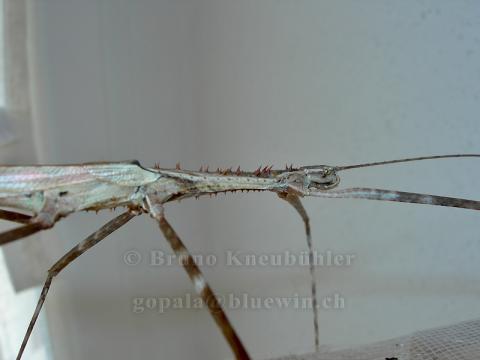
Genus
Species
Stock
Culture status
In culture
Foodplants
Bramble (Rubus spp.)
Breeding notes
(by Bruno Kneubuehler)
General Infomations
- this species has originally been described by Westwood as Cyphocrania tamyris (1859)
- other synonyms are Sosibia tamyris (Kirby, 1904), Centrophasma infernale(Redtenbacher, 1908)
- in Europe, this species has been cultured since a long time. Several new culture stocks have been importet over the years
_________________
Origin
- Tapah Hills (Malaysia), below the Cameroon Highlands
_________________
Female
- medium sized, fully winged phasmids
- body length is about 10 - 11 cm
- there are many prominent spines on the thorax
- the membranous part of the hind wings is beautifully pink-black coloured. This warning colour is shown only when they feel strongly disturbed
- they can fly, but do so only very rarely
- basic colour is brown in different shades, with an almost white band along the sides of the head and the thorax
_________________
Males
- thin, equally fully winges phasmids
- body lenghts is about 9 cm
- males have even more prominent spines on the thorax
- the membranous part of their hind wings is also pink-black coloured. But they do not display these warning colours, not even when feeling threatened
- they are good flyers and do so quite eaily
- their basic colour is also brown in different shades, with an almost white band along the sides of the head and the thorax
_________________
Food Plants
- they feed easily on bramble (Rubus sp.)
_________________
Eggs
- cone-shaped, dark brown
- surface is roughly structured
- about 6 mm long and 2.5 mm wide
_________________
Breeding Notes
- very easy to culture
- incubation of the eggs on damp (not too wet) sand, with springtails to reduce mould growth
- incubation time (at room temperatures) is about 5 months
- nymphs are mainly green
- Faunaboxes are great for bringing these nymphs up
- males will mature after about 4,5 months, females after about 5 months
- just prior to the adult moult, the wing buds will turn pink
- males will stay for 2-3 days together with the same female, but leave her eventually
- females start about 2 months after their final moult to lay eggs
- they stick the eggs into a substrate, which has to be provided for them (like peat, moss, soil)











